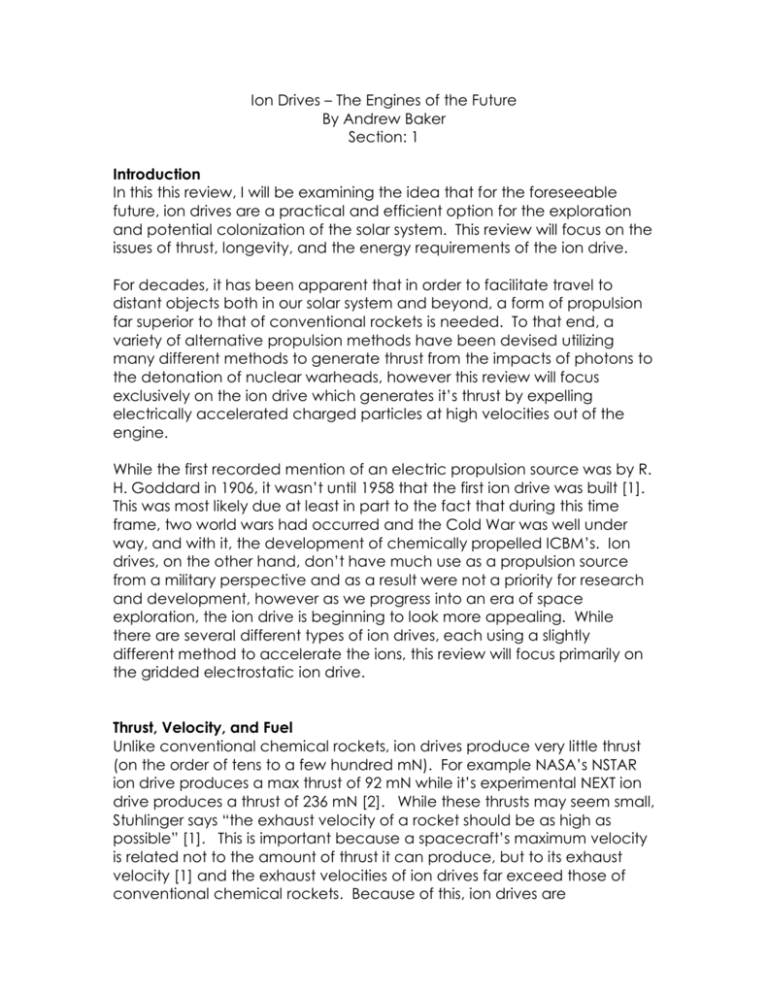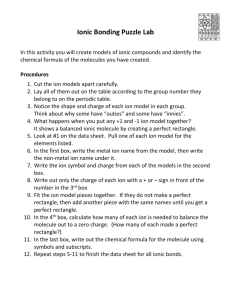Literature Review Ion Drives
advertisement

Ion Drives – The Engines of the Future By Andrew Baker Section: 1 Introduction In this this review, I will be examining the idea that for the foreseeable future, ion drives are a practical and efficient option for the exploration and potential colonization of the solar system. This review will focus on the issues of thrust, longevity, and the energy requirements of the ion drive. For decades, it has been apparent that in order to facilitate travel to distant objects both in our solar system and beyond, a form of propulsion far superior to that of conventional rockets is needed. To that end, a variety of alternative propulsion methods have been devised utilizing many different methods to generate thrust from the impacts of photons to the detonation of nuclear warheads, however this review will focus exclusively on the ion drive which generates it’s thrust by expelling electrically accelerated charged particles at high velocities out of the engine. While the first recorded mention of an electric propulsion source was by R. H. Goddard in 1906, it wasn’t until 1958 that the first ion drive was built [1]. This was most likely due at least in part to the fact that during this time frame, two world wars had occurred and the Cold War was well under way, and with it, the development of chemically propelled ICBM’s. Ion drives, on the other hand, don’t have much use as a propulsion source from a military perspective and as a result were not a priority for research and development, however as we progress into an era of space exploration, the ion drive is beginning to look more appealing. While there are several different types of ion drives, each using a slightly different method to accelerate the ions, this review will focus primarily on the gridded electrostatic ion drive. Thrust, Velocity, and Fuel Unlike conventional chemical rockets, ion drives produce very little thrust (on the order of tens to a few hundred mN). For example NASA’s NSTAR ion drive produces a max thrust of 92 mN while it’s experimental NEXT ion drive produces a thrust of 236 mN [2]. While these thrusts may seem small, Stuhlinger says “the exhaust velocity of a rocket should be as high as possible” [1]. This is important because a spacecraft’s maximum velocity is related not to the amount of thrust it can produce, but to its exhaust velocity [1] and the exhaust velocities of ion drives far exceed those of conventional chemical rockets. Because of this, ion drives are Baker 2 theoretically able to achieve velocities far greater (on the order of at least 5 times greater) than that of conventional rockets, even though they generally have accelerations in the order of 10e-4 g’s [1]. This is extremely beneficial for the exploration of our solar system as not only does the higher spacecraft velocity allow for significantly reduced mission times (which lead to huge cost savings), but as ion drives weigh less than conventional rockets, the mass difference at launch can be replaced with scientific equipment, (making each mission not only shorter, but more productive) [4], or eliminated by the use of a smaller takeoff rocket which is less expensive to launch [3]. Brophy [3] describes a sample return mission from a comet where an ion drive propelled spacecraft could bring samples back in just over seven years while a conventional spacecraft would take over nine years just to get there with no option to bring samples back. Noca [4] agrees with using ion drives for this and goes so far as to say that SEP (Solar Electric Propulsion) is an enabling technology for this type of mission. This mission has all of the abovementioned advantages over a conventional chemical rocket. While ion drives produce significantly less thrust than a conventional rocket, the same also holds true for their fuel consumption. They essentially “sip” fuel (generally between 0.24 and 0.36 mg/s according to Brophy and Noca). This means that they can carry significantly less fuel then would conventionally be needed, which allows more space for scientific equipment, or conversely a significantly increased time in which the engine is capable of providing thrust. This combination of low thrust and low fuel consumption means that ion drives have a high specific impulse. Impulse and Longevity Specific Impulse is a term used to define the efficiency of a rocket engine. It represents the force of the engine with respect to the fuel used per unit time and for the purpose of this review, has units of seconds. Generally speaking, the higher the specific impulse of an ion drive, the more powerful it is. NASA’s current state of the art NSTAR class of ion drive has a specific impulse of 3100 s [3], while its next generation of ion drives (NEXT) has a specific impulse of 4100 s [2]. This is a huge improvement in only a few years. Just imagine what kinds of impulses will be possible a few engine generations down the road. If ion drives are appealing now, they will be mission enabling in the future, and could become the preferred propulsion method of both manned and unmanned spacecraft. Aside from their high impulses, ion drives have another unique aspect; they are able to run for prolonged periods of time. During one test described by Brophy, the NSTAR was operated at full power for 8192 hours Baker 3 before being voluntarily shut down after having produced a total impulse of 2.73e6 N s and using 88 kg of xenon fuel [3]. This is over 341 days of continuous operation. Similarly, Patterson and Benson discuss a test of the NEXT drive in which it was operated for over 9990 hours (more than 416 days) at full power [2]. While these may seem like a long time, the most impressive part is that Brophy, Patterson, and Benson all agree that at the ends of their tests, the engines showed no signs of being anywhere close to failing. This shows that given adequate fuel and power, ion drives have the potential to be operated continuously for over a year, perhaps more at full power without fear of failing. This is a characteristic that is crucial for any deep space mission. Energy Requirements The only potential drawback and real limitation of ion drives is their energy consumption, which unlike their thrust and fuel consumption is anything but small. NASA’s NSTAR drive requires between 0.5-2.3 kW while their NEXT drive requires between 0.5-6.9 kW [2]. Remember that this power requirement is for an individual drive and many systems in which these drives will be used will contain upwards of three or four drives which will be operated simultaneously (though not necessarily at full power). As a result the power system must be able to generate enough energy to power all the drives at full power. Currently, there are two practical methods that can be used, nuclear and solar. Stuhlinger is a firm proponent of the use of fission reactors while Brophy, Noca, Patterson, and Benson all believe in using solar power. For the time being solar is the preferred method as nuclear generation not only adds a significant amount of mass to the craft, but also greatly increases its cost and complexity. The primary downside to using solar energy to power the craft is that the energy that can be generated from a solar array of a fixed size is directly proportional to the distance the array is from the sun (If you double your distance from the sun the power you can generate decreases by a factor of 4). This however does provide an interesting side effect. For mission safety reasons, NASA requires a safety margin on the operation of ion drives. This means that while they can be operated at full power, the average power at which they operate must be less than their maximum by a predetermined amount. For the case of the NSTAR drive, even though the maximum power is 2.3 kW, the average at which they are allowed to operate is less than 2.1 kW [3]. Because of the solar array’s diminishing capacity to produce power as the distance from the sun increases, craft utilizing this power source automatically meet this requirement. Conclusion While it is obvious that there is still a lot of research and development to be done with ion drives, their potential for use on both manned and Baker 4 unmanned spacecraft is just as obvious. As we enter an age in which our curiosity cannot be satisfied by simply observing the planets and stars, we are in need of technology that will enable us to actually go there. To that end, ion drives are a practical and efficient solution for the foreseeable future. Their low thrust is more than compensated for by their high impulse, low fuel consumption, and ability to run for extended periods of time, which give them the ability to attain velocities impossible with conventional technologies. The only limitation we have come across is the significant amount of energy they consume. As a result, research should be directed into either finding a way to reduce this energy consumption, or make our current methods of energy generation more efficient. Ion drives are truly a propulsion source that we are only just beginning to realize. Baker 5 References 1. E. Stuhlinger, Ion Propulsion For Space Flight. New York, NY: McGRAW-Hill, 1964, pp. xviii – 10. 2. M. J. Patterson, S. W. Benson, “NEXT Ion Propulsion System Development Status and Performance”, in AIAA/ASME/SAE/ASEE Joint Propulsion Conference & Exhibit., Cincinatti., OH, 2007, pp. 1 – 17. 3. J. Brophy, “Advanced Ion Propulsion Systems for Affordable DeepSpace Missions”, Acta Astroautica, vol. 52, no. 2-6, pp. 309 – 316. Mar, 2003. 4. J. R. Brophy, M. Noca, “Electric Propulsion for Solar System Exploration”, Journal of Propulsion and Power, vol. 14, no. 5, pp. 700 – 707, Oct., 1998.







